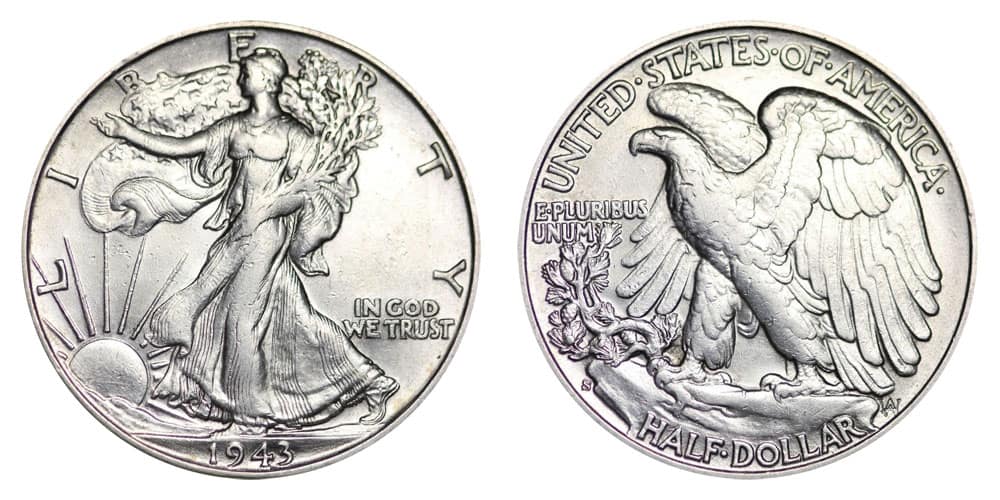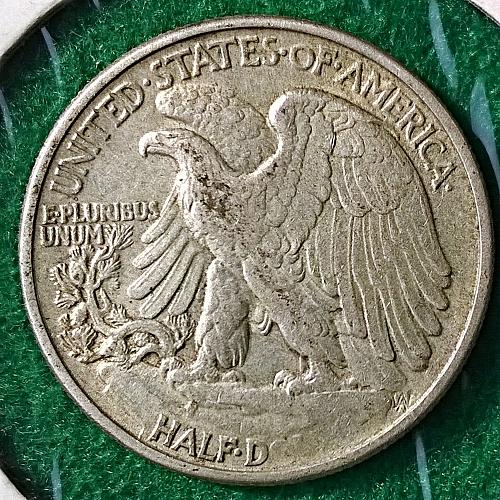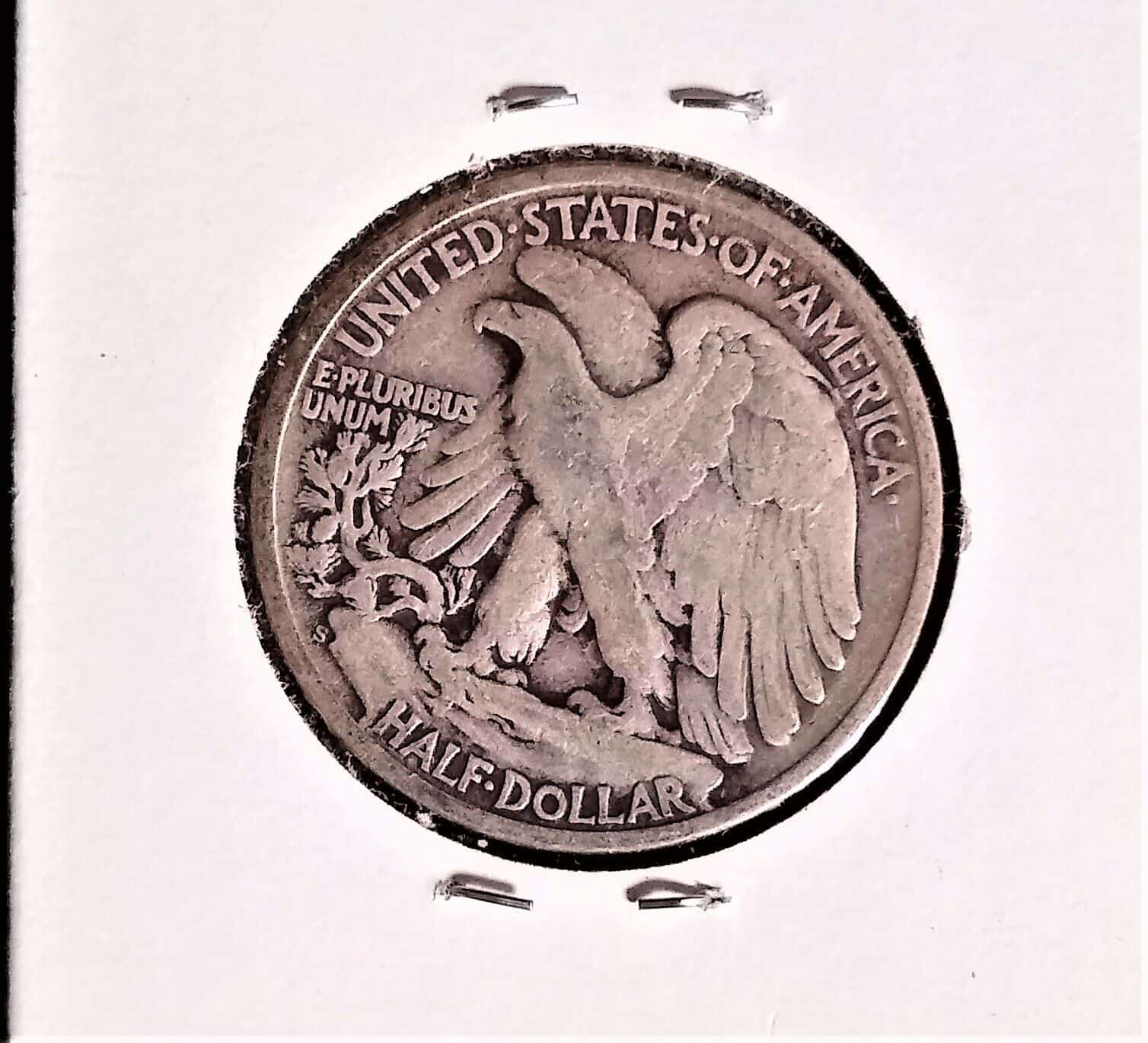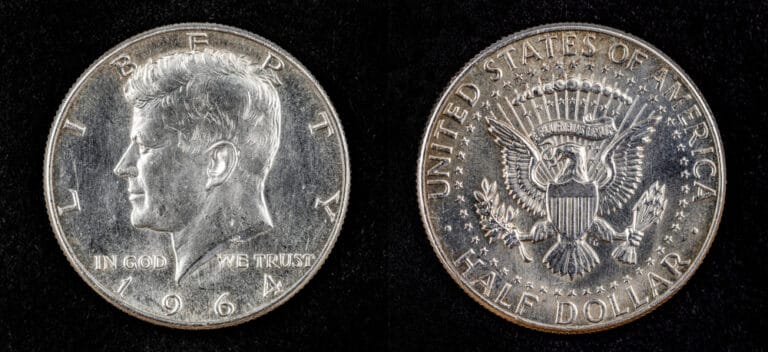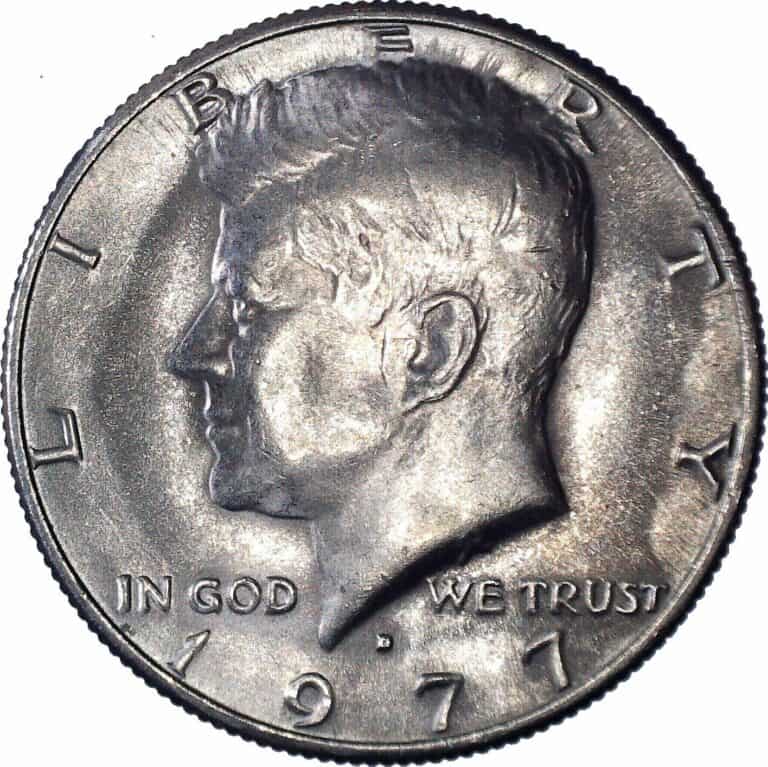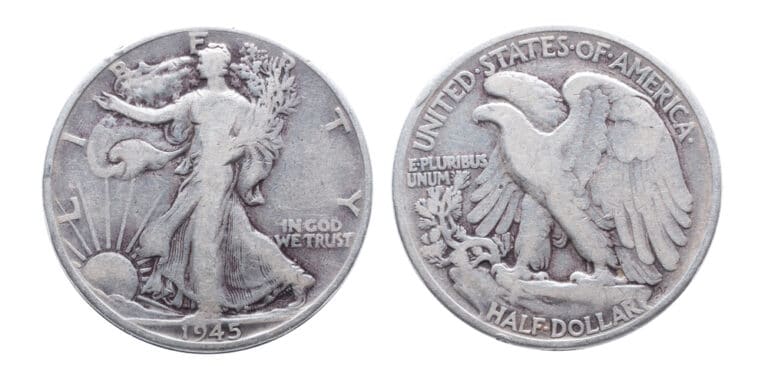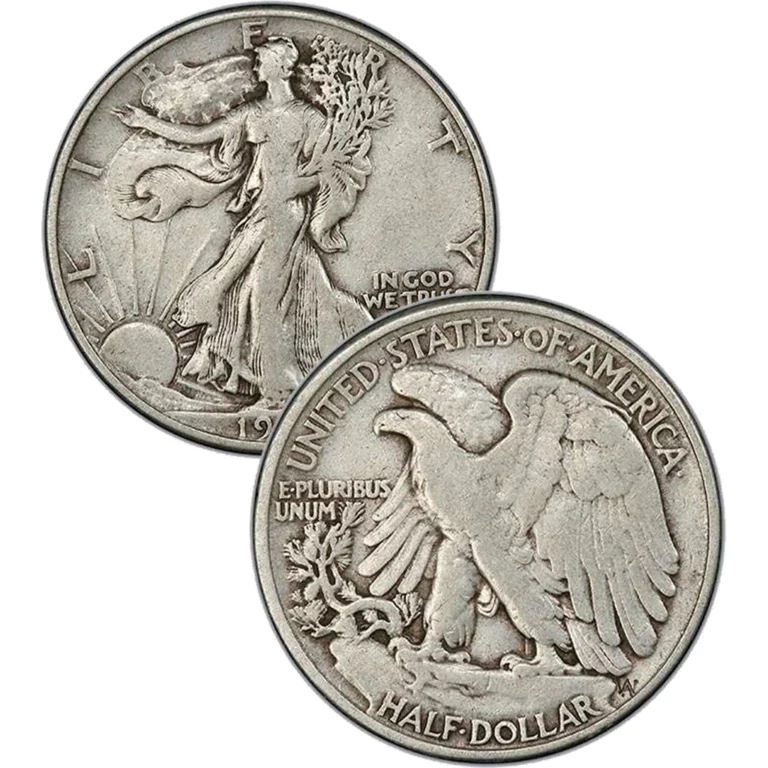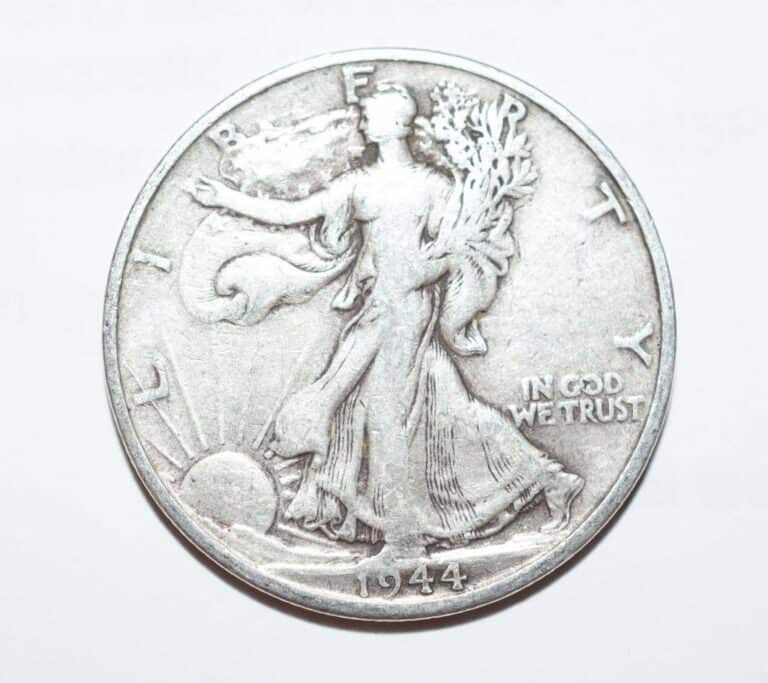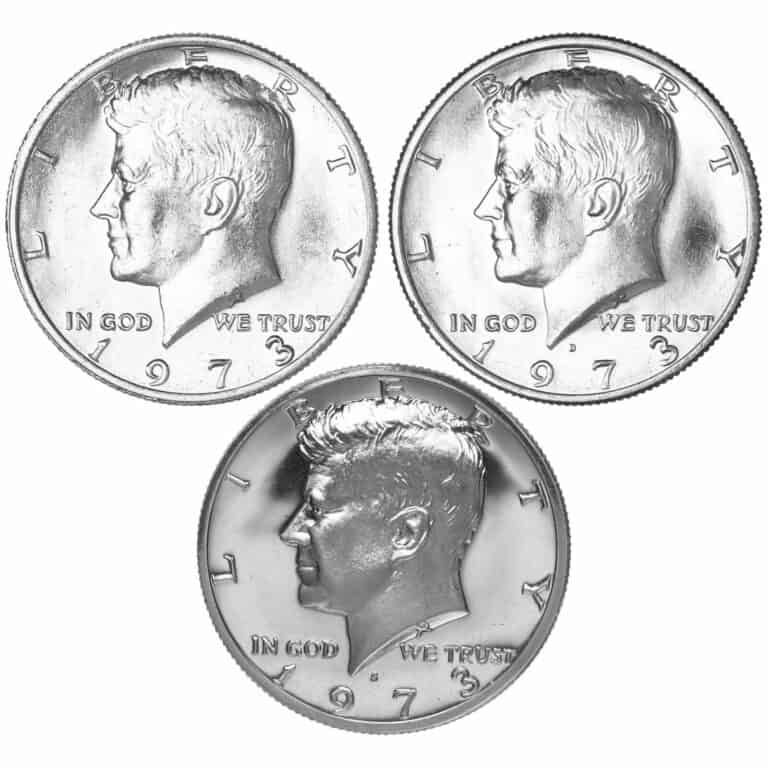1943 Half Dollar Value: How Much is it Worth Today?
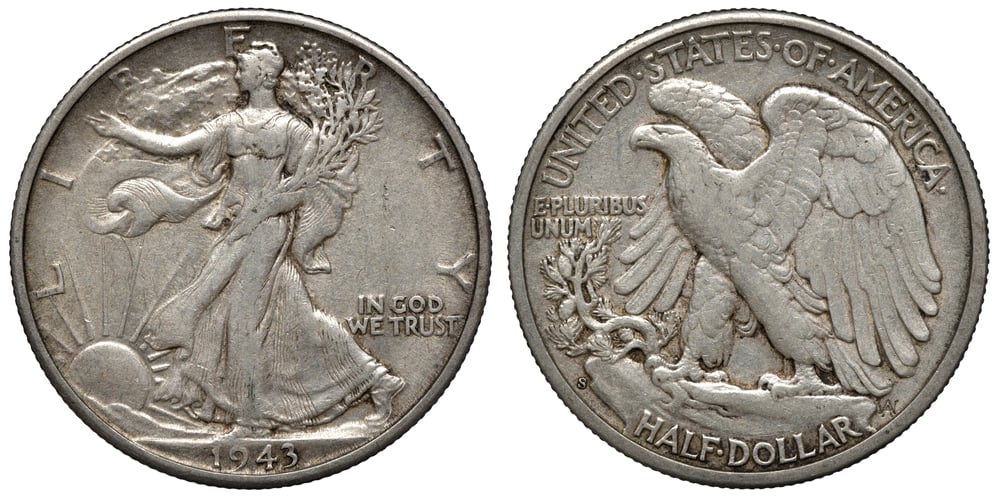
Fashioned by the renowned sculptor Adolph Weinman, the Walking Liberty half dollar is one of the most poetic and beautiful coins to ever be produced by U.S. Mints. It was first minted in 1916 and became such a popular coin because of its lovely, creative design.
Today, we’ll be zeroing in on the 1943 half dollar value, varieties, errors, and more. If you have a Walking Liberty half dollar dated 1943, you might be surprised how much it costs today. We’ll tell you this much—it’s worth way more than just 50 cents in the modern age.
Ready to learn more about this exquisite coin? Keep scrolling to learn more about the 1943 Walking Liberty half dollar.
1943 Half Dollar Value Chart |
|||||
| Mint Mark | Good | Extremely Fine | AU58 About Uncirculated | MS65 Gem Uncirculated | MS67 Superb Gem Uncirculated |
| 1943 No Mint Mark Half Dollar Value | $11.75 | $18.25 | $30 | $115 | $550 |
| 1943 “D” Mint Mark Half Dollar Value | $11.75 | $18.25 | $45 | $155 | $575 |
| 1943 “S” Mint Mark Half Dollar Value | $11.75 | $18.25 | $45 | $220 | $4,000 |
1943 No Mint Mark Half Dollar Value
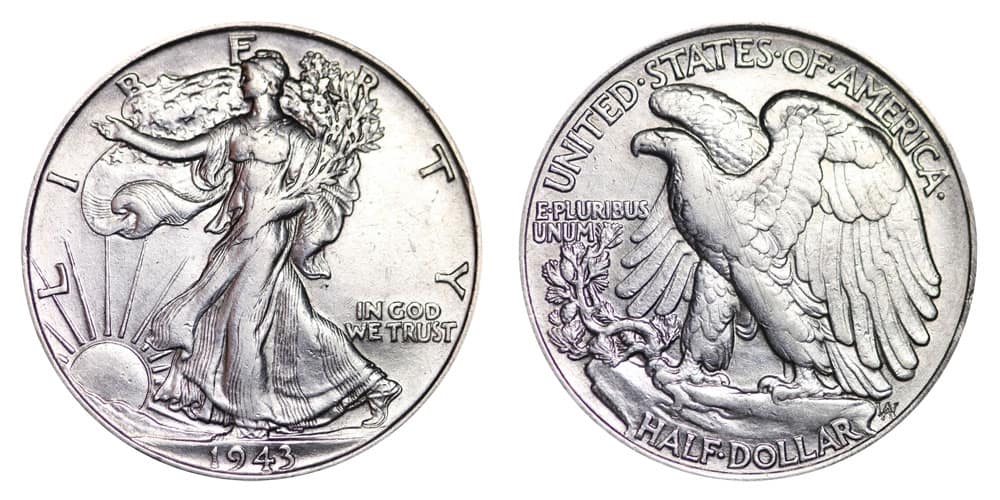
In the early 1900s, U.S. administrations tried time and again to rejuvenate the U.S. coinage and make the coins beautiful again. The Walking Liberty half dollar was a result of these efforts.
The 1943 half dollar follows the same Walking Liberty design first minted in 1916. The year before, Adolph A. Weinman battled it out with two other sculptors—Hermon A. MacNeil and Albin Polasek—to see who was cut out for designing some of the Liberty coins.
Weinman’s Walking Liberty design was given to the half dollar. But that’s not the only design of his that the U.S. Treasury loved. He was also able to bag another of the most popular Liberty coins—the Mercury (or Winged Liberty) dime.
The Walking Liberty’s obverse shows a full-length Lady Liberty walking towards the sun, seemingly holding out hope for a new day. She is adorned with stars and stripes to symbolize America. She also carries oak and laurel branches, symbolizing peace.
On the upper rim of the obverse are the letters that spell out “LIBERTY.” To the right of Lady Liberty is the phrase, “In God We Trust,” and below her feet is the date of 1943.
Meanwhile, the reverse shows an American eagle sitting on a mountain cliff, where on the corner, a pine sapling is growing. Around the rim are the words “United States of America” and “Half Dollar.” You’ll also see the designer’s initials “AW” on the bottom, to the right of the denomination.
Reeded edges add even more to the 1943 half dollar’s beauty. It weighs a total of 12.5 grams, thanks to its high silver fineness of 90%. Today, its melt value is at around $7.95.
In 1943, Philadelphia didn’t just mint the highest number of coins for that year—it also minted the most coins for the Walking Liberty half dollar series thus far. The Philly mint ended up striking some 53 million half dollars that year.
The 1943 (P) half dollars are valuable even in poor, circulated condition. At a barely recognizable PO1, this half dollar can be valued at $11.25. And in extremely fine, circulated condition, it’s worth $18.25. These high values are likely due to the rising melt value of silver.
At the higher end of the spectrum of circulated coins, the price more than doubles. At AU58 (about uncirculated), the value of a 1943 (P) half dollar sits at $30.
There are tons of uncirculated coins in circulation for this issue today. It’s quite common and easy to find from grades MS62 to MS66. However, it’s still important to double-check if these half dollars were struck properly by fresh dies before investing in them, regardless of their high grade.
An MS62 coin can be valued at around $45. Meanwhile, half dollars of superb gem uncirculated grades like MS66 and MS67 can be sold at $170 and $550, respectively. And in pristine, near-perfect condition at MS68, you can expect your 1943 (P) half dollar to be worth $6,000.
1943 “D” Mint Mark Half Dollar Value
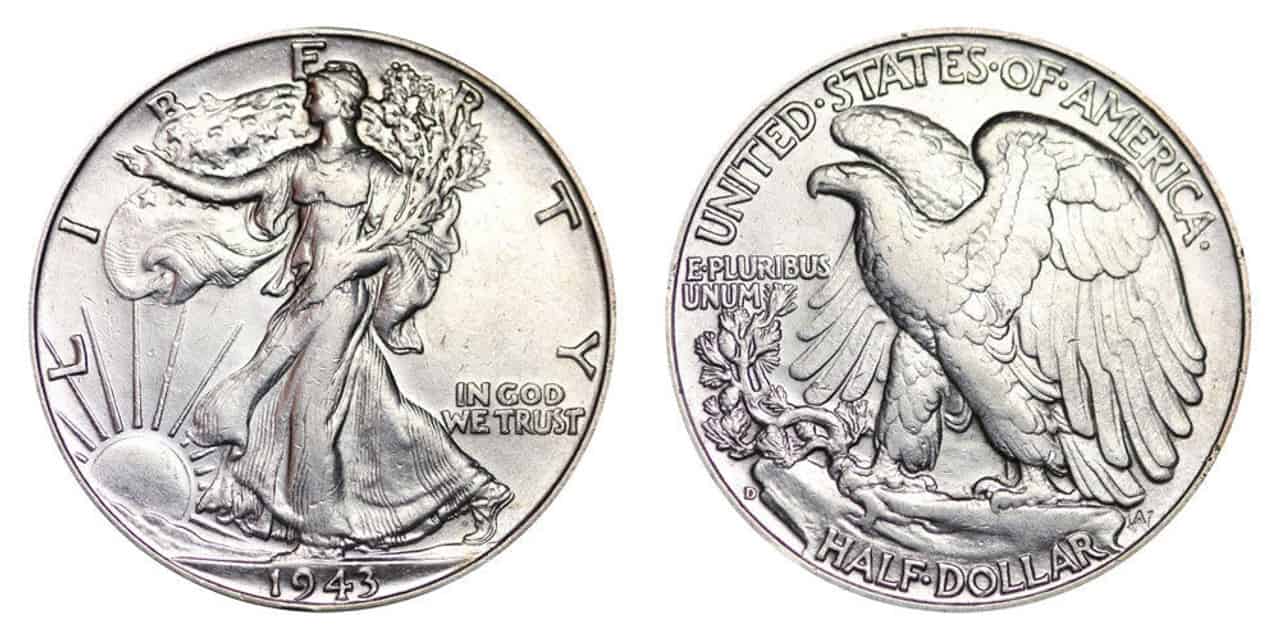
Like the Philly issue, the Denver mintage of the 1943 half dollar was quite high for its time. The Denver Mint ended up producing 11.3 million half dollars in 1943. And like many of the coins produced in Denver, these Walking Liberty half dollars were consistently well-struck.
These coins are distinguishable through their “D” mint mark. You can find this on the obverse, to the left of the denomination, and right under the mountain pine sapling growing out of the mountain cliff.
Even if the 1943 D half dollars are way scarcer than the Philadelphia-minted coins of that year, their value isn’t that much higher. In fact, in circulated conditions, they are worth the same as their Philadelphia cousins.
In good, circulated condition, the 1943 D half dollar can be valued at $11.75. This number rises to $18.25 at extremely fine condition, $30 at AU53, and $45 at AU58—the highest circulated grade.
When it comes to uncirculated conditions, the 1943 D half dollar is most common from MS64 to MS66, placing their value anywhere between $110 and $250. Of course, some are also graded higher than MS66, but the number drops off quite fast at grade MS67 and above.
If you do happen to have your 1943 D half dollar graded at MS67, you will be looking at a value of $575. Just a little higher at MS67+, and your coin has the potential to sell for around $1,650.
And if you have a pristine, high-luster MS68-grade coin, you might be able to sell it for $7,000 or more. One of these finely-graded coins was sold in 2021 for a whopping $36,000! This was due to its bold, distinctive strike and beautiful, frosty texture.
1943 “S” Mint Mark Half Dollar Value
As with most coins, the 1943 S half dollar is the most valuable among all half dollars minted that year, especially in mint grades. The San Francisco Mint created just shy of 13.5 million Walking Liberty half dollars—the highest production the Frisco Mint has had in this series since 1918.
Many of the mint-state 1943 S half dollars have a poor to average strike, which doesn’t do a lot of justice to Weinman’s stunning Walking Liberty design. So, a rare 1943 S half dollar with bold lines and striking eye appeal should be given a high, mint-state grade.
Aside from being the most valuable among the three varieties of 1943 half dollars, the San Francisco-minted coins of that year are also known to sometimes lack Adolph Weinman’s “AW” initials on the reverse—but more on that later!
In poor to extremely fine condition, the 1943 S half dollar has the same values as that of 1943 (P) and 1943 D series. It ranges from $11.25 to $18.25. At AU58, it has the same value as the Denver-minted coins of that grade at $45.
In uncirculated condition, the 1943 S half dollar is common across all grades but is especially plentiful in MS64 and MS65. These coins can be valued today at $110 and $220, respectively.
Any higher than an MS65, you’ll see the value of the 1943 S half dollars skyrocket. At MS66, you might be able to sell your coin for $500. And if you’re lucky enough to have your coin graded MS67 or MS67+, you can expect it to be valued from $4,000 to $10,000.
1943 Half Dollar Grading
The modern-day value of any 1943 half dollar is heavily dependent on coin grading. Circulated coins are less valuable than mint-state, uncirculated ones. Here are a few signs to look for when trying to figure out your 1943 half dollar’s grade:
Extremely Fine (Circulated):
- Smoothing on the more detailed areas of the design, like Liberty’s hair and the eagle’s wings
- Light to moderate wear with little luster
MS60 and Above (Uncirculated):
- Lustrous and shiny with great visual appeal and just a few contact marks
- Bold, distinct lines in the design
- No wear even on the highest points of the coin
Need a hand figuring out whether your coin is circulated or uncirculated? Learn how to grade 1943 Walking Liberty half dollars by watching this guide:
Rare 1943 Half Dollar Error List
There are lots of errors you might be able to find on your 1943 half dollar. All you need is a coin microscope to look at the key areas of the coin to find them.
Here are some errors you can look for in your 1943 half dollar:
1943 Half Dollar Doubled Die Obverse Error
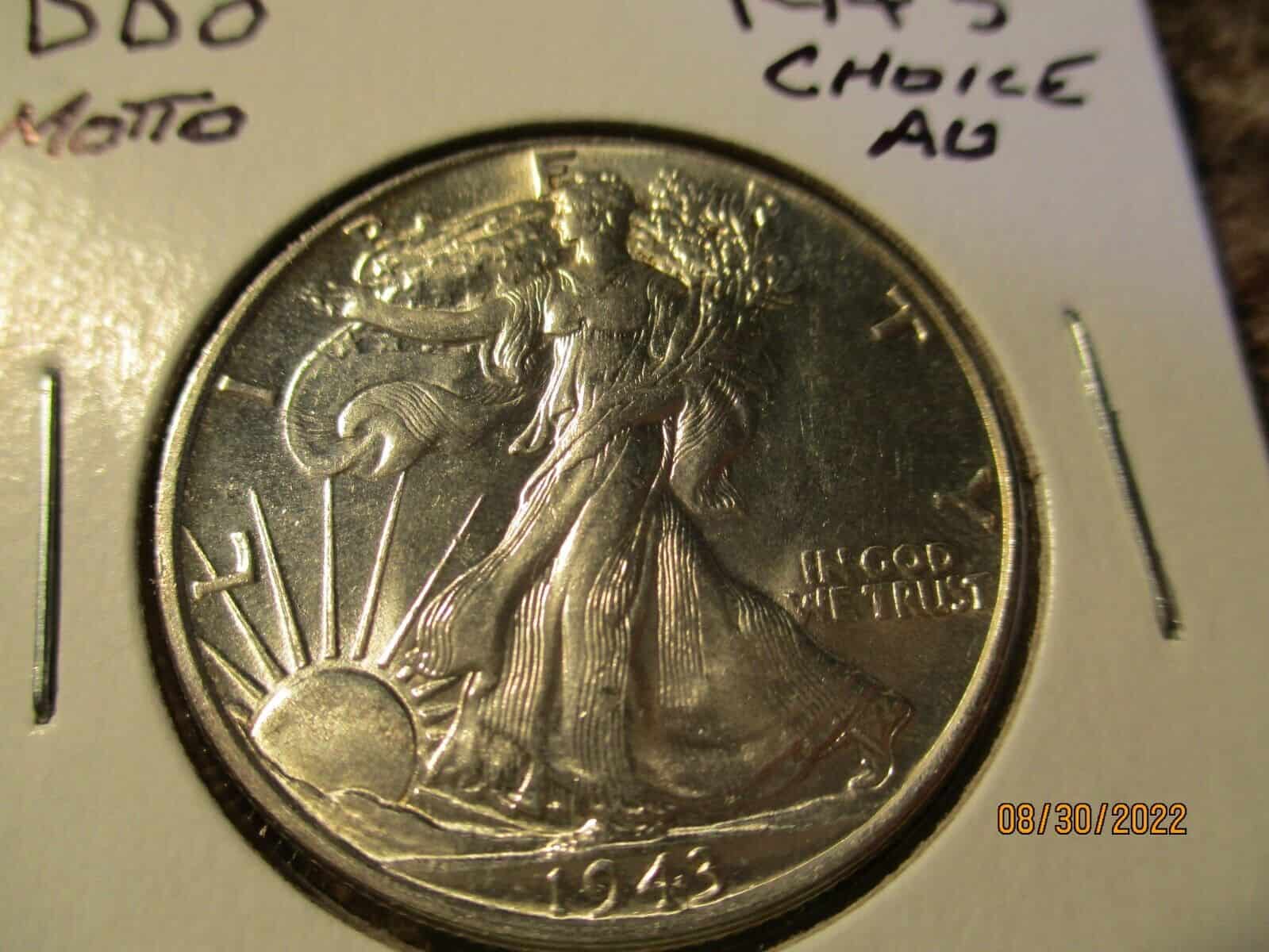
There are many doubled die 1943 half dollars from all three mints that produced it. This was probably the result of a faulty master die that ended up striking a faint second image of certain letters and numbers on the coins.
One 1943 D half dollar was even found with doubling near Lady Liberty’s chin. The coin was an MS65 and was sold for over $235.
1943 Half Dollar Struck on Peru 50C Planchet Error
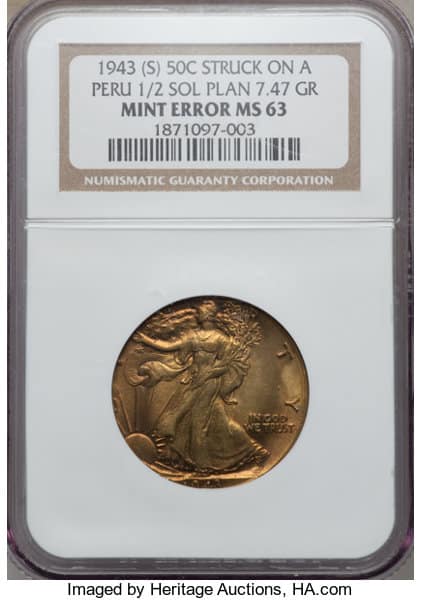
One of the most valuable errors to have been found on a 1943 half dollar is having been struck on a Peruvian 50-cent planchet. In 1943, the U.S. helped out Peru by minting some of their half-sol coins.
At least a few of their brass 50-cent planchets must have been left behind at the mints, creating this rare coin error.
Only two such coins have been found to date, and both are immensely valuable. One of them even sold for $21,000!
1943 Half Dollar Reverse Strike-Through Error
When a coin is “struck through,” it means a small object or piece of debris (like staples or metal shavings) came between the die and the planchet right before it was struck. As a result, the shape of that item remains on the coin.
A strike-through error has once been found on the reverse of an MS66 1943 (P) half dollar. If you zoom into the eagle’s middle, between its breast and wing, you’ll see a strike-through right in the center. This coin ended up selling for $160.
1943 Half Dollar No AW initials on Reverse Error
In some San Francisco 1943 half dollars, the initials of Adolph Weinman are missing. One worn, circulated coin sold for over $36 because of this error. We’re sure that if it was a coin with a higher, mint-state grade, it would have been way more valuable.
1943 Half Dollar FAQs
Is a 1943 half dollar pure silver?
While a 1943 Walking Liberty half dollar isn’t made purely of silver, it has a silver fineness of 90%. The other 10% of the coin is made of copper. A 90% silver coin is extremely valuable because its worth is always tied to the melt value of silver. As of March 2023, that price is nearing $8.
How much is a 1943 D Liberty half dollar worth?
The value of a 1943 D Walking Liberty half dollar depends on its condition. In circulated grades, the price goes anywhere between $11 (in poor condition) and $45 (at AU58, about uncirculated condition). In mint states, a Denver-minted 1943 half dollar can go up to $7,000 in grade MS68.
How can you tell if a half dollar is real silver?
If you want to make sure that your 1943 half dollar is made of silver, turn it to its side and look at its edge. If you see a faint copper stripe that goes through the edge, it’s likely a copper coin, not a silver one. Silver coins don’t have that faint line on their edges.
Where is the mint mark on 1943 half dollar?
If your 1943 half dollar was minted in Denver or San Francisco, you’ll find the corresponding mint mark on the reverse of the coin. A tiny “D” or “S” should sit right below the mountain pine, to the left of the letter “H” in “Half Dollar.”
